Balsamic Vinegar Reduction Glaze Recipe
Love the delicious balsamic glaze drizzled over your food at restaurants? You can make it at home with 4 ingredients, in 10 minutes. Adds a special touch to chicken, steak or vegetables.
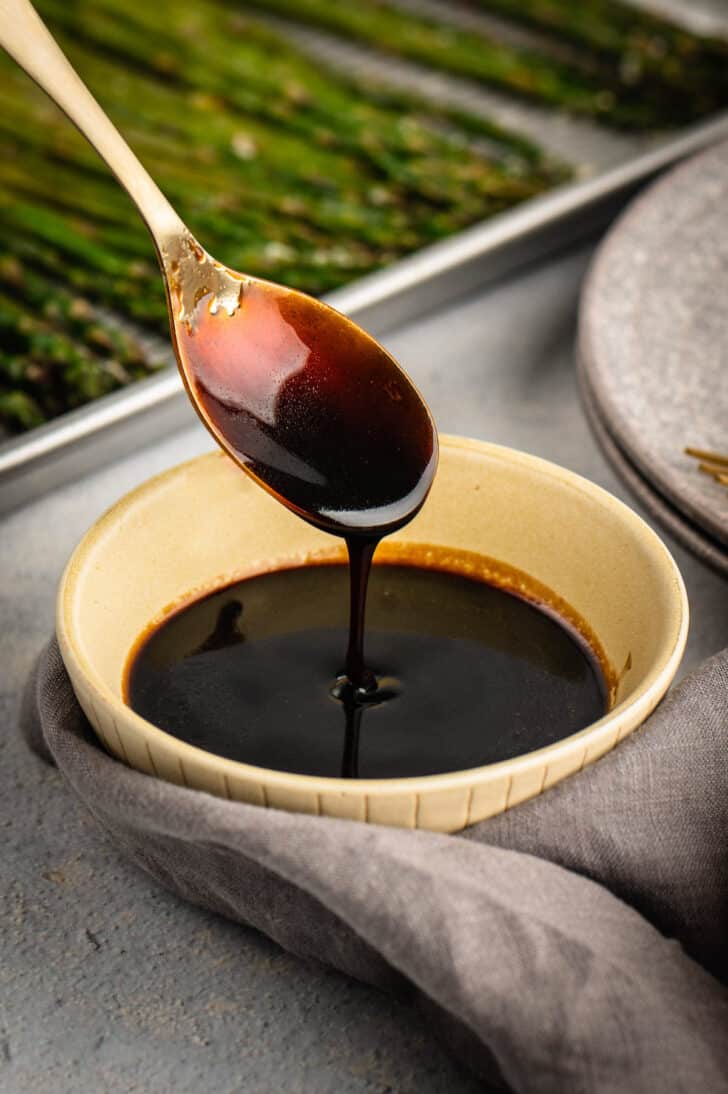
“I loved this recipe. I used it to dress a compressed watermelon salad with mint, basil, feta and pistachios. Highly recommend.”
—Rose
What is balsamic glaze?
I spent a lot of my time in culinary school making balsamic vinegar reduction to be used as a glaze. The restaurant that the school ran used it to finish a variety of dishes.
We would drizzle it over everything from chicken pizza to braised short ribs to add a special finishing touch to the dish.
There’s nothing like the smell of a big pot of vinegar boiling away on the stove to wake you up at 5 in the morning (which is when I had to report to some classes).
Over the past few years, I’ve noticed various brands of pre-made glazes make their way onto grocery store shelves.
Brands must have figured out that home chefs wanted to use this ingredient, but were perhaps too intimidated to make it themselves.
I admit, I’ve even bought the pre-made stuff myself from time to time, but if you have a few extra minutes and a few simple ingredients, it really is so easy to make it yourself at home.
Today, I’m taking the intimidation factor out of the equation with this simple balsamic vinegar glaze recipe.
Why You’ll Love This Balsamic Vinegar Glaze Recipe
- Making your own glaze is cost-effective compared to purchasing a pre-made glaze, adding big flavor to your meals in an economical way.
- Once made, balsamic vinegar reduction can be stored in the fridge for up to 10 days, so you can enjoy it for several meals.
Balsamic Glaze Ingredients
- balsamic vinegar – it goes without saying that this is the key ingredient! Because you’ll be reducing the vinegar to half of its original volume, that means the flavor will concentrate, too. Which means you’ll want to start with a nice mid-range vinegar. Doesn’t need to be super high end, but it’s also not the time to use the really cheap bargain stuff, either. Eataly has a lot of good information on how to buy balsamic vinegar.
- light brown sugar – this balances the acidity of the vinegar and adds to the syrupy consistency of the final product.
- soy sauce – this isn’t traditional in most glaze recipes, but it is in mine. Rather than salt, I use soy sauce to season the glaze, because it also adds a punch of umami, too.
- unsalted butter – I like to swirl in a pat of butter at the end of the cooking process, to enhance the mouthfeel and flavor of the glaze.
How to make the Best Balsamic Glaze
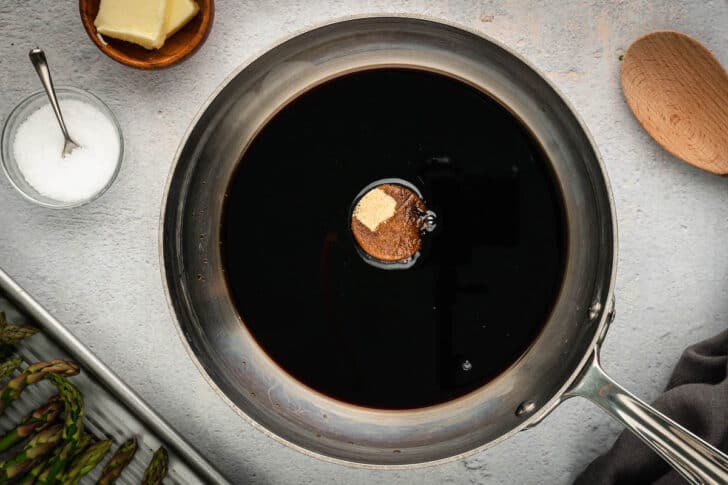
1. COMBINE. Place vinegar, brown sugar and soy sauce in a medium saucepot.

2. REDUCE. Heat to boiling, then reduce heat to a simmer and cook until mixture is reduced by half, swirling occasionally. You’ll know it’s done when your finger leaves a line in the mixture on the back of a spoon.
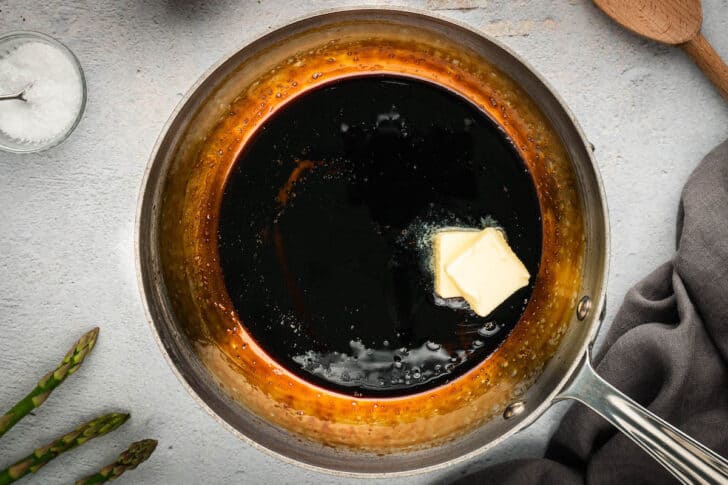
3. FINISH. Remove the glaze from heat and stir in the butter. Let cool before using so that the glaze can finish thickening.
Home Chef Tips for Balsamic Reduction Glaze
- Exact timing for how long it will take for the vinegar to reduce into a glaze will depend on your stove and what type of saucepot you are using.
- It’s very easy to go from perfectly reduced to burnt in less than a minute, so don’t wander away from the kitchen while the mixture is reducing. Keep a close eye on it!
- The glaze will thicken considerably as it cools, so if the mixture seems too thin after you add the butter, give it a chance to cool down.
How to use Balsamic Glaze
Use this recipe to make balsamic glazed chicken or balsamic glazed salmon!
This glaze is so good when served over a variety of protein. It’s great on lamb lollipops. It’s also delicious served over roasted or grilled chicken, like caprese chicken breasts.
I love drizzling it over thinly sliced, rare steak so grilling flat iron steak and putting it into steak lettuce wraps with a drizzle of glaze is one of my favorite meals.
It also adds a special finishing touch to my sockeye salmon recipe, shrimp or almost any other type of seafood you can think of.
It’s also perfect for vegetables: balsamic glazed carrots or asparagus!
This glaze recipe also really shines when it’s served with vegetables. I love balsamic roasted carrots and balsamic green beans, and asparagus roasted, my radicchio salad recipe and mini Hasselback potatoes drizzled with glaze.
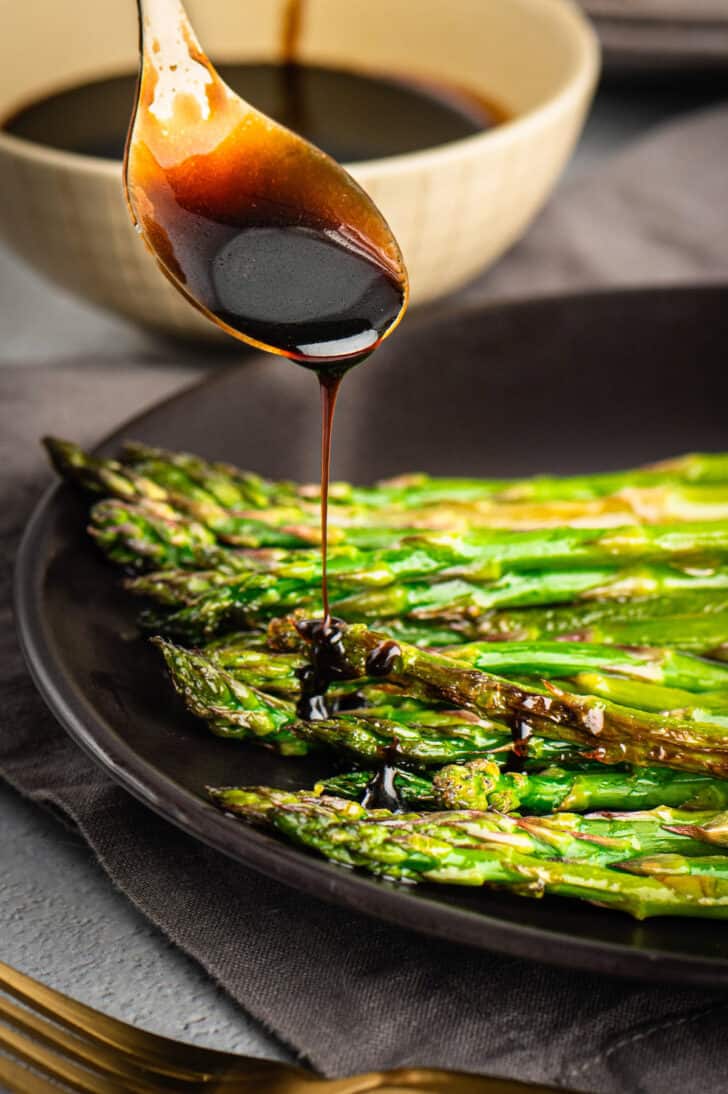
Save This Recipe!
Balsamic Glaze Storage
How long does Balsamic Glaze last?
Homemade glaze lasts about 7 to 10 days in an airtight container.
Does Balsamic Glaze need to be refrigerated?
Because my balsamic vinegar glaze recipe contains butter, it does need to be refrigerated. Because it sets up and gets very thick under refrigeration, remove it from the fridge about an hour before serving to allow it to come to room temperature and return to it’s drizzly consistency.
Balsamic Vinegar Glaze FAQs
Balsamic glaze and balsamic vinegar may seem similar, but they’re not quite the same.
Balsamic vinegar is a dark, concentrated grape vinegar used in salad dressings and marinades.
Balsamic glaze, also known as balsamic reduction, is a syrupy sauce made by simmering balsamic vinegar and often adding sweeteners like sugar or honey. It is thicker, sweeter, and more syrup-like compared to regular vinegar.
The two terms are often used interchangeably, but there can be slight variations.
“Balsamic reduction” is a broader term that simply refers to the process of simmering balsamic vinegar until it thickens. It may or may not include additional sweeteners.
“Balsamic glaze” is a type of balsamic reduction that typically includes sweeteners, so it has a sweeter taste compared to a basic balsamic reduction. It is often used as a finishing drizzle for dishes to add flavor and visual appeal.
Balsamic glaze is a very versatile condiment that can elevate a wide range of dishes, including salads, grilled meats, cheese, roasted vegetables, fruit, pizza, sandwiches and desserts.
Glaze should be stored in the refrigerator to prolong its shelf life.
More Foxes Love Lemons Favorites
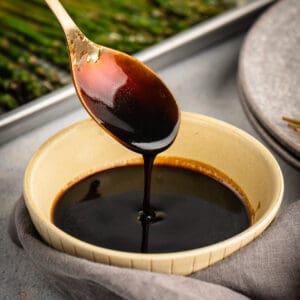
Balsamic Vinegar Reduction
Save This Recipe!
Ingredients
- 1 cup balsamic vinegar
- 2 tablespoons light brown sugar
- 2 teaspoons soy sauce
- 2 tablespoons unsalted butter
Instructions
- Place vinegar, brown sugar and soy sauce in medium saucepot. Heat to boiling over high heat, then reduce heat to medium.
- Simmer 8 to 12 minutes or until mixture is reduced by half, swirling occasionally, watching very carefully so it does not burn.
- Remove glaze from heat and stir in butter. Let cool before using. Glaze will thicken considerably as it cools.
Notes
- Exact timing for how long it will take for the vinegar to reduce into a glaze will depend on your stove and what type of saucepot you are using.
- It’s very easy to go from perfectly reduced to burnt in less than a minute, so don’t wander away from the kitchen while the mixture is reducing. Keep a close eye on it!
- The glaze will thicken considerably as it cools, so if the mixture seems too thin after you add the butter, give it a chance to cool down.


This is more of a question. How much lamb does this recipe call for? We’ve 8 pieces of lamb chops, do we double the glaze ingredients for 8 chops?
Hi Kellie – I would make a double batch of the glaze for 8 chops, just to be safe!
I loved this recipe.
I used it to dress a compressed watermelon salad with mint,basil.feta and chili pistachios.
Highly recommend.
I’m so glad that you liked it! Your salad sounds amazing.